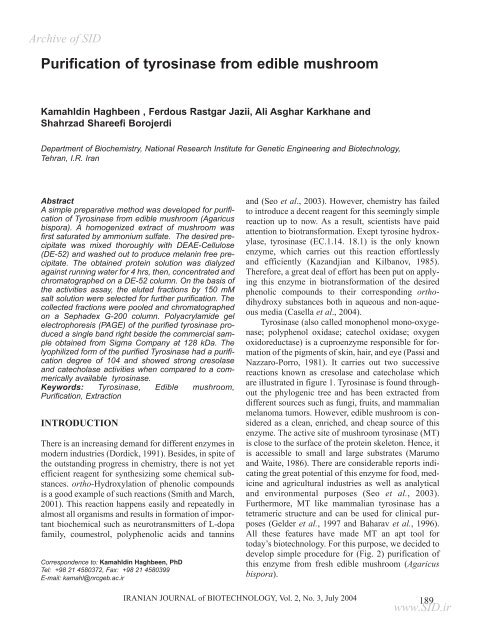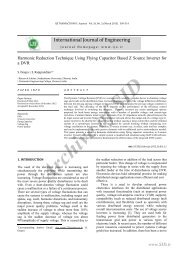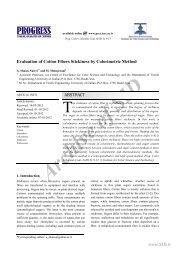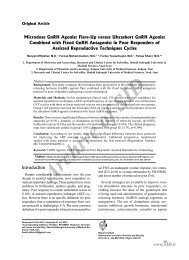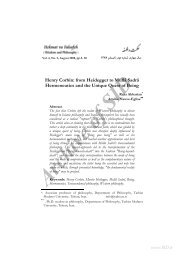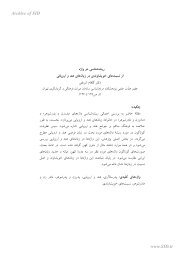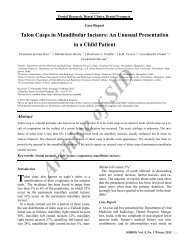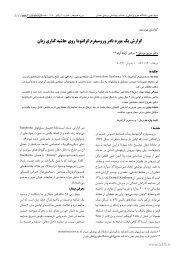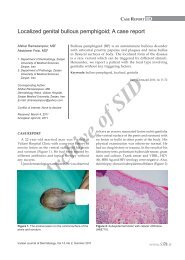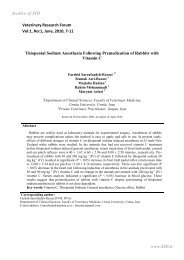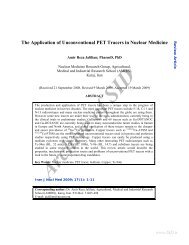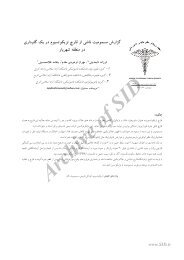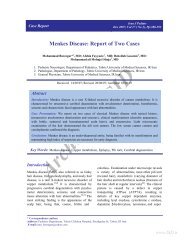Purification of tyrosinase from edible mushroom
Purification of tyrosinase from edible mushroom
Purification of tyrosinase from edible mushroom
Create successful ePaper yourself
Turn your PDF publications into a flip-book with our unique Google optimized e-Paper software.
Archive <strong>of</strong> SID<br />
<strong>Purification</strong> <strong>of</strong> <strong>tyrosinase</strong> <strong>from</strong> <strong>edible</strong> <strong>mushroom</strong><br />
Kamahldin Haghbeen , Ferdous Rastgar Jazii, Ali Asghar Karkhane and<br />
Shahrzad Shareefi Borojerdi<br />
Department <strong>of</strong> Biochemistry, National Research Institute for Genetic Engineering and Biotechnology,<br />
Tehran, I.R. Iran<br />
Abstract<br />
A simple preparative method was developed for purification<br />
<strong>of</strong> Tyrosinase <strong>from</strong> <strong>edible</strong> <strong>mushroom</strong> (Agaricus<br />
bispora). A homogenized extract <strong>of</strong> <strong>mushroom</strong> was<br />
first saturated by ammonium sulfate. The desired precipitate<br />
was mixed thoroughly with DEAE-Cellulose<br />
(DE-52) and washed out to produce melanin free precipitate.<br />
The obtained protein solution was dialyzed<br />
against running water for 4 hrs, then, concentrated and<br />
chromatographed on a DE-52 column. On the basis <strong>of</strong><br />
the activities assay, the eluted fractions by 150 mM<br />
salt solution were selected for further purification. The<br />
collected fractions were pooled and chromatographed<br />
on a Sephadex G-200 column. Polyacrylamide gel<br />
electrophoresis (PAGE) <strong>of</strong> the purified <strong>tyrosinase</strong> produced<br />
a single band right beside the commercial sample<br />
obtained <strong>from</strong> Sigma Company at 128 kDa. The<br />
lyophilized form <strong>of</strong> the purified Tyrosinase had a purification<br />
degree <strong>of</strong> 104 and showed strong cresolase<br />
and catecholase activities when compared to a commerically<br />
available <strong>tyrosinase</strong>.<br />
Keywords: Tyrosinase, Edible <strong>mushroom</strong>,<br />
<strong>Purification</strong>, Extraction<br />
INTRODUCTION<br />
There is an increasing demand for different enzymes in<br />
modern industries (Dordick, 1991). Besides, in spite <strong>of</strong><br />
the outstanding progress in chemistry, there is not yet<br />
efficient reagent for synthesizing some chemical substances.<br />
ortho-Hydroxylation <strong>of</strong> phenolic compounds<br />
is a good example <strong>of</strong> such reactions (Smith and March,<br />
2001). This reaction happens easily and repeatedly in<br />
almost all organisms and results in formation <strong>of</strong> important<br />
biochemical such as neurotransmitters <strong>of</strong> L-dopa<br />
family, coumestrol, polyphenolic acids and tannins<br />
Correspondence to: Kamahldin Haghbeen, PhD<br />
Tel: +98 21 4580372, Fax: +98 21 4580399<br />
E-mail: kamahl@nrcgeb.ac.ir<br />
and (Seo et al., 2003). However, chemistry has failed<br />
to introduce a decent reagent for this seemingly simple<br />
reaction up to now. As a result, scientists have paid<br />
attention to biotransformation. Exept tyrosine hydroxylase,<br />
<strong>tyrosinase</strong> (EC.1.14. 18.1) is the only known<br />
enzyme, which carries out this reaction effortlessly<br />
and efficiently (Kazandjian and Kilbanov, 1985).<br />
Therefore, a great deal <strong>of</strong> effort has been put on applying<br />
this enzyme in biotransformation <strong>of</strong> the desired<br />
phenolic compounds to their corresponding orthodihydroxy<br />
substances both in aqueous and non-aqueous<br />
media (Casella et al., 2004).<br />
Tyrosinase (also called monophenol mono-oxygenase;<br />
polyphenol oxidase; catechol oxidase; oxygen<br />
oxidoreductase) is a cuproenzyme responsible for formation<br />
<strong>of</strong> the pigments <strong>of</strong> skin, hair, and eye (Passi and<br />
Nazzaro-Porro, 1981). It carries out two successive<br />
reactions known as cresolase and catecholase which<br />
are illustrated in figure 1. Tyrosinase is found throughout<br />
the phylogenic tree and has been extracted <strong>from</strong><br />
different sources such as fungi, fruits, and mammalian<br />
melanoma tumors. However, <strong>edible</strong> <strong>mushroom</strong> is considered<br />
as a clean, enriched, and cheap source <strong>of</strong> this<br />
enzyme. The active site <strong>of</strong> <strong>mushroom</strong> <strong>tyrosinase</strong> (MT)<br />
is close to the surface <strong>of</strong> the protein skeleton. Hence, it<br />
is accessible to small and large substrates (Marumo<br />
and Waite, 1986). There are considerable reports indicating<br />
the great potential <strong>of</strong> this enzyme for food, medicine<br />
and agricultural industries as well as analytical<br />
and environmental purposes (Seo et al., 2003).<br />
Furthermore, MT like mammalian <strong>tyrosinase</strong> has a<br />
tetrameric structure and can be used for clinical purposes<br />
(Gelder et al., 1997 and Baharav et al., 1996).<br />
All these features have made MT an apt tool for<br />
today’s biotechnology. For this purpose, we decided to<br />
develop simple procedure for (Fig. 2) purification <strong>of</strong><br />
this enzyme <strong>from</strong> fresh <strong>edible</strong> <strong>mushroom</strong> (Agaricus<br />
bispora).<br />
IRANIAN JOURNAL <strong>of</strong> BIOTECHNOLOGY, Vol. 2, No. 3, July 2004 189<br />
www.SID.ir
Archive <strong>of</strong> SID<br />
Figure 1. Cresolase (mono-oxygenase) and catecholase (oxidase)<br />
activities <strong>of</strong> <strong>tyrosinase</strong>. “I” and “II” represent the synthetic substrates<br />
used for assaying the cresolase and catecholase activities <strong>of</strong><br />
MT, respectively. See the Methods section for the details.<br />
MATERIALS AND METHODS<br />
MT and bovine serum albumin were purchased <strong>from</strong><br />
Sigma Chemical Co. (USA). Sephadex G-50 and G-<br />
200 were purchased <strong>from</strong> pharmacia and<br />
Diethylaminoethyl cellulose (DE-52) <strong>from</strong> Whatman <br />
(Maidstone, UK). Phenyl methyl sulphonyl fluoride<br />
(PMSF) was obtained <strong>from</strong> Merck . 4-[(4-<br />
Methylphenyl)azo]-phenol (MePAPh) and 4-[(4methylbenzo)azo]-1,<br />
2-benzenediol (MeBACat),<br />
assigned as “I” and “II” in figure 1, were prepared as<br />
described earlier (Haghbeen and Tan, 1998). Fresh <strong>edible</strong><br />
<strong>mushroom</strong> was bought <strong>from</strong> the market and frozen<br />
at -20°C. All the other chemicals and reagents, needed<br />
for electrophoresis and buffer preparation, were taken<br />
<strong>from</strong> the authentic samples. Double-distilled water<br />
was used for preparing the desired solutions.<br />
Assay <strong>of</strong> MT activities: In this study, all the enzymatic<br />
reactions were run in phosphate buffer solution,<br />
PBS, (10 mM) at pH 6.8 and constant temperature,<br />
20±0.1°C. The final volume <strong>of</strong> all the reaction mixtures<br />
was 3 ml filling up three quarters <strong>of</strong> the conventional<br />
UV-Vis cuvette, 1-cm width. Freshly prepared<br />
MT was used for both the cresolase and catecholase<br />
activities. Using a Beckman (DU Series 70) spectrophotometer,<br />
the rate <strong>of</strong> the enzymatic reaction <strong>of</strong><br />
MT was monitored as described previously (Haghbeen<br />
and Tan, 2003). Therefore, the cresolase and catecholase<br />
activities were assayed through the depletion<br />
<strong>of</strong> MePAPh (λ max = 352 nm) and MeBACat (λ max = 364<br />
nm), respectively. The results presented in this article<br />
190<br />
Haghbeen et al.<br />
are the averages <strong>of</strong>, at least, triplicate measurements.<br />
Protein extraction: 250 g <strong>of</strong> the frozen <strong>mushroom</strong><br />
was homogenized in 300 ml <strong>of</strong> Tris-HCl buffer (50<br />
mM, pH 5.8) containing 1 mM <strong>of</strong> PMSF. The suspension<br />
was stirred for 30 min at room temperature and<br />
filtered through a cotton mesh. The filtrate was centrifuged<br />
at 13500×g for 30 min at 4°C using a<br />
Beckman Centrifuge, J-21 model. The resulting supernatant<br />
was separated and subjected to ammonium sulfate<br />
precipitation.<br />
Ammonium sulfate precipitation: Ammonium sulfate<br />
powder was added to the collected supernatant<br />
<strong>from</strong> the former step to make a 35% saturated solution.<br />
The resulting solution was stirred in an ice bucket for<br />
30 min, then, centrifuged for 30 min at 1500×g and<br />
4°C. Ammonium sulfate was added to the obtained<br />
supernatant to make a 70% saturated solution. The<br />
solution was left stirring on ice for 2h, then, centrifuged<br />
for 30 min at 1500×g and 4°C. The supernatant<br />
was discarded and the resulting precipitate was<br />
dissolved in Tris-HCl (50 mM, pH 5.8).<br />
Desalting and chromatography: In order to desalt<br />
the obtained protein solution <strong>from</strong> the previous stage,<br />
it was chromatographed on a G-50 column (2.6×45cm,<br />
Pharmacia) using Tris-HCl buffer (50 mM, pH 5.8) as<br />
the mobile phase. The output <strong>of</strong> the column was monitored<br />
spectrophotometrically at λ max = 280 nm. Then,<br />
the collected fractions were checked for the cresolase<br />
and catecholase activities in the presence <strong>of</strong> MePAPh<br />
and MeBACat, respectively. The fractions with high<br />
activities were pooled. Desalting was also achieved by<br />
dialysis. Dialysis was carried out against Tris-HCl<br />
buffer (50 mM, pH 6.8) at 4°C over night.<br />
Ion exchange chromatography: The dialyzed protein<br />
solution <strong>from</strong> the previous step was loaded onto ion<br />
exchange (DE-52) column and passed through by Tris-<br />
HCl buffer (50 mM, pH 6.8). Then, the proteins were<br />
eluted <strong>from</strong> the column using NaCl solution. The collected<br />
protein fractions at 150 mM salt eluent were<br />
pooled and concentrated by lyophylization.<br />
Gel filtration: To purify further the lyophilized sample<br />
obtained <strong>from</strong> the previous step, it was dissolved in<br />
PBS and loaded on a Sephadex G-200 column<br />
(10×100 mm Pharmacia). The column washed with<br />
PBS. The ensuing fractions were collected and<br />
checked for the presence <strong>of</strong> the protein. The quality <strong>of</strong><br />
the purified <strong>tyrosinase</strong> was evaluated by PAGE and<br />
activities assays results.<br />
www.SID.ir
Archive <strong>of</strong> SID<br />
Electrophoresis and determination <strong>of</strong> protein concentration:<br />
Polyacrylamide gel electrophoresis<br />
(PAGE) was performed by the method <strong>of</strong> Laemmli<br />
(1970). Accordingly, the protein solution was subjected<br />
to electrophoresis on 10% resolving and 4% stacking<br />
polyacrylamide gel at a constant electrophoretic<br />
field <strong>of</strong> 200 V. The protein bands were visualized by<br />
staining with Coomassi brilliant blue G250. The observations<br />
were double-checked by silver nitrate-stain<br />
method. The protein concentration was determined<br />
using Bradford method (Bradford, 1976).<br />
RESULTS<br />
Aceton wash<br />
Protein Ext.<br />
by aceton 30% sol<br />
Ammonioum sulfate<br />
precipitation at two steps<br />
Sephadex G-25<br />
gel chromatography<br />
Hydroxylapatite<br />
gel chromatography<br />
Protein Ext.<br />
by PBS<br />
Ammonium sulfat<br />
precipitation at two steps<br />
Calcium phosphate<br />
chromatography<br />
Sephadex G-25<br />
gel chromatography<br />
De-52<br />
Ion -Exchange<br />
chromatography<br />
Nelson and Mason Duckworth and Sigma Jolley Method NRCGEB<br />
Coleman<br />
Figure 2. Schematic illustration <strong>of</strong> the discussed purification procedures. See the results and discussion section for the details.<br />
Removal <strong>of</strong> melanins: The accompanying melanins<br />
which are usually built up during preparation <strong>of</strong> the<br />
homogenized extract could be extensively removed<br />
<strong>from</strong> the protein mixture using ion-exchange material.<br />
See the discussion section for the detail.<br />
Ion-exchange chromatography: The eluted fractions<br />
obtained by salt solution (150 mM) <strong>from</strong> a DE-52 col-<br />
Dehydration<br />
Aqueouse Ext.<br />
Solvent<br />
precipitation<br />
Calcium salt<br />
precipitation<br />
Ammonium sulfate<br />
precipitation<br />
Dialysis<br />
againast water<br />
Liquid N 2<br />
homogenized<br />
Na benzoate<br />
ammonium sulfate<br />
saturated sol.<br />
Ammounium sulfate<br />
precipitation<br />
Sephadex G-200<br />
gel chromatography<br />
Hydroxylapatite<br />
gel chromatotograghy<br />
Protein Ext.<br />
by PBS<br />
Ammonium sulfate<br />
precipitation at two steps<br />
Sephadex G-50<br />
gel chromatography<br />
DE-52<br />
Ion-exchange<br />
chromatography<br />
Dialysis<br />
against PBS<br />
Sephadex G-200<br />
gel chromatography<br />
umn showed high catecholase activity and <strong>tyrosinase</strong><br />
content. These results are illustrated in figsures 3 and<br />
4, respectively.<br />
Figure 3. The chromatogram <strong>of</strong> the ion-exchange chromatography<br />
stage. Absorbance (∆) refers to the optical density for each collected<br />
fraction at λ max = 280 nm and activity (Ò) means the rate <strong>of</strong> the<br />
catecholase reaction for each fraction. See the methods section for<br />
the detail.<br />
IRANIAN JOURNAL <strong>of</strong> BIOTECHNOLOGY, Vol. 2, No. 3, July 2004 191<br />
www.SID.ir
Archive <strong>of</strong> SID<br />
Figure 4. The PAGE result <strong>of</strong> the collected fractions eluted <strong>from</strong><br />
the DE-52 column in comparison with the commercial (Sigma)<br />
sample.<br />
Gel-chromatography: The desired collected fractions<br />
<strong>from</strong> the ion-exchange chromatography step were<br />
mixed, concentrated and loaded on a Sephadex G-200<br />
column. The purified MT at this stage produced a single<br />
band beside the commercial sample at about 128<br />
kDa.<br />
Activity enhancement and purification degree: The<br />
collected protein after removing <strong>of</strong> melanins and<br />
desalting had a catecholase activity <strong>of</strong> 6.258 (rate per<br />
ml) and a purification degree <strong>of</strong> 6.6. Similarly, the collected<br />
fractions <strong>from</strong> the ion-exchange chromatography<br />
stage and the purified MT collected <strong>from</strong> the gel<br />
chromatography step showed catecholase activities <strong>of</strong><br />
6.276 and 8.77, correspondingly, and purification<br />
degrees <strong>of</strong> 29 and 104, respectively. The detailed<br />
results are summarized in table 1.<br />
192<br />
Haghbeen et al.<br />
DISCUSSION<br />
Table 1. The total results <strong>of</strong> each stage <strong>of</strong> the developed method for the MT purification.<br />
Although there are numerous methods for extracting<br />
and purifying <strong>of</strong> <strong>tyrosinase</strong>s <strong>from</strong> different sources;<br />
there are only a few methods for purification <strong>of</strong> MT<br />
which have been cited repeatedly in the literature<br />
(Healey and Strothkamp, 1981; Toussaint and Lerch,<br />
1987; Koga et al., 1992; Espin et al., 1997; Fenoll et<br />
al., 2004). These procedures are illustrated beside the<br />
method, which is used by Sigma for preparation <strong>of</strong><br />
the commercial MT (Haghbeen, 1998), and the developed<br />
method in this lab in figure 2. Edible <strong>mushroom</strong><br />
contains a considerable amount <strong>of</strong> various phenolic<br />
compounds, which are readily oxidized during the<br />
homogenizing process. Upon oxidation and successive<br />
polymerization <strong>of</strong> the phenolic content <strong>of</strong> the <strong>mushroom</strong><br />
extract, macromolecules <strong>of</strong> melanins are formed.<br />
Separating the unwanted melanins <strong>from</strong> the protein<br />
content <strong>of</strong> the extract is the first, or probably the most,<br />
important task during the MT purification.<br />
As shown in figure 2, the Nelson and Mason<br />
method (Nelson and Mason, 1970) starts with the acetone<br />
wash <strong>of</strong> the homogenized extract to collect the<br />
phenolic substances in the organic solvent at the beginning.<br />
An almost similar trick, solvent precipitating, is<br />
applied in the Sigma procedure. Using an organic<br />
solvent can prevent the melanin formation to a great<br />
extent, but increases the proteins denaturation risk.<br />
This is why Duckworth and Coleman had used Ca 3<br />
(PO 4) 2 chromatography to separate melanins<br />
(Duckworth and Coleman, 1970).<br />
To stop all the possible chemical reactions, Jolly<br />
et al. had homogenized <strong>mushroom</strong> in liquid nitrogen<br />
(Jolley et al., 1974). Then, they had precipitated all<br />
the protein content <strong>of</strong> the extract by a saturated sodium<br />
benzoate- ammonium sulfate solution. This method is<br />
also suffering <strong>from</strong> two clear drawbacks. First, they<br />
* rate refers to the change in the optical density <strong>of</strong> MeBACat at λ max = 364 nm per minute during its reaction with the collected enzyme.<br />
To obtain the amount <strong>of</strong> the used substrate, the reported data has to be divided to the extinction coefficient <strong>of</strong> MeBACat at λ max = 364<br />
nm which is 15400 M -1 .cm -1 (Haghbeen and Tan, 2003).<br />
www.SID.ir
Archive <strong>of</strong> SID<br />
have homogenized <strong>mushroom</strong> in liquid nitrogen at<br />
very low temperature. Under these conditions, phenolic<br />
compounds might not dissolve in liquid medium<br />
and remain absorbed on the protein and cell debris surface.<br />
Second, after carrying out the homogenizing step<br />
in liquid nitrogen, the obtained pulp has to be transferred<br />
into the aqueous medium, which inevitably triggers<br />
melanin formation.<br />
To tackle the melanin formation problem during<br />
MT purification, two other solutions have been introduced<br />
in more recent works. In the first work, Nunez-<br />
Nunez-Delicado et al. (1996) have trapped the<br />
hydrophobic proteins and the phenolic content <strong>of</strong> the<br />
extract into a micelle system using Triton X-114. In<br />
the second work, Rescigno et al. (1997) have applied a<br />
diafiltration against ascorbic acid solution. The presence<br />
<strong>of</strong> ascorbic acid avoids the oxidation <strong>of</strong> the phenolics<br />
by keeping them in the reduced form throughout<br />
the extraction phase until their complete removal.<br />
These solutions have their own disadvantages. The<br />
former method needs micelle formation and trapping<br />
phenolic compounds and hydrophobic proteins in it,<br />
which is cumbersome by its own. In the diafiltration<br />
method, a large amount <strong>of</strong> ascorbic acid or another<br />
reducing agent has to be utilized, which makes the procedure<br />
more expensive.<br />
Experiments in this lab, however, showed that it is<br />
possible to get rid <strong>of</strong> both phenolic and melanin contaminants<br />
at the ion-exchange chromatography stage.<br />
This procedure was started by homogenizing the <strong>edible</strong><br />
<strong>mushroom</strong> in PBS at 4°C. Therefore, no organic<br />
solvent was used at this stage. However, it was essential<br />
to carry out this step at cold temperature and as fast<br />
as possible. After removing the cell debris, the protein<br />
content <strong>of</strong> the homogenized extract was precipitated at<br />
35% and 70% <strong>of</strong> saturation point <strong>of</strong> ammonium sulfate.<br />
The collected heavy proteins showed very weak<br />
catecholase activity and were put aside.<br />
It is necessary to reduce the salt content <strong>of</strong> a protein<br />
mixture before loading it onto an ion-exchange<br />
column. Therefore, the collected proteins by 70% saturated<br />
ammonium sulfate were chromatographed on a<br />
Sephadex G-50 column. Doing so, not only ammonium<br />
sulfate was substituted by buffer, but also large<br />
amount <strong>of</strong> phenolic compounds were washed down.<br />
Besides, the protein components were fractioned during<br />
elution. However, this stage can be replaced by<br />
dialyzing the protein mixture against running water or<br />
buffer; if fractionation is not necessary.<br />
Figures 3 and 4 shows the results <strong>of</strong> the ionexchange<br />
chromatography <strong>of</strong> the collected protein<br />
mixture on a DE-52 column. As it was mentioned earlier<br />
in this paper, it is possible to omit both the pheno-<br />
lics and melanin impurities <strong>from</strong> the protein mixture at<br />
this stage. As a matter <strong>of</strong> fact, melanins show very high<br />
affinity for DE-52 polymer. When the mixture <strong>of</strong> protein<br />
and melanin is loaded on the DE-52 column and<br />
successively washed by molar solution <strong>of</strong> NaCl, this is<br />
only the protein which is released. In other words,<br />
melanin sticks firmly to DE-52. Therefore, it is suggested<br />
to replace the Sephadex G-50 step, showed in a<br />
dashed square in figure 2, by a three-step stage;<br />
Dialysis, mixing with DE-52 and releasing the proteins<br />
and again dialysis.<br />
The final stage in Jolly et al., (1974) and Moss and<br />
Rosenblum (1972) methods involve in applying<br />
hydroxylapatite chromatography. It is known that<br />
hydroxylapatite is a strong protein absorbent which is<br />
usually used for separation <strong>of</strong> isozymes. MT is a mixture<br />
<strong>of</strong> four isozymes and all <strong>of</strong> them are capable <strong>of</strong><br />
doing both cresolase and catecholase reactions.<br />
Therefore, there is no need to decrease the final yield<br />
to an isozyme, unless it is really needed. Considering<br />
the average molecular weight <strong>of</strong> MT, it was preferred<br />
to apply Sephadex G-200 instead <strong>of</strong> hydroxylapatite at<br />
the final stage. The PAGE result <strong>of</strong> the purified MT<br />
sample has shown in figure 5 and the results <strong>of</strong> the<br />
whole purification stages have been summarized in<br />
table 1. It is understood <strong>from</strong> the results that the<br />
amount <strong>of</strong> the total protein had been decreased to<br />
0.64% <strong>of</strong> the initial extracted protein whereas its catecholase<br />
activity had been increased to ten-fold <strong>of</strong> the<br />
initial activity. In conclusion, it is important to mention<br />
that similar results were observed for the cresolase<br />
Figure 5. The PAGE result <strong>of</strong> the purified MT obtained <strong>from</strong> the<br />
G-200 column in comparison with the commercial (Sigma) sample<br />
and BSA.<br />
IRANIAN JOURNAL <strong>of</strong> BIOTECHNOLOGY, Vol. 2, No. 3, July 2004 193<br />
www.SID.ir
Archive <strong>of</strong> SID<br />
activity <strong>of</strong> the purified MT in the presence <strong>of</strong> MePAPh.<br />
However, it is easier to follow MT purification steps<br />
by monitoring its catecholase reaction. The catecholase<br />
reaction <strong>of</strong> MT is about ten times faster than<br />
its cresolase reaction.<br />
Acknowledgment<br />
This research was totally supported by the National Institute<br />
for Genetic Engineering and Biotechnology (NIGEB) and<br />
carried out as the first phase <strong>of</strong> the Project number 203.<br />
References<br />
Baharav E, Merimski O, Shoenfeld Y, Zigelman R, Gilbrud<br />
B, Yecheskel G, Youinou P, Fishman P (1996).<br />
Tyrosinase as an autoantigen in patients with vitiligo,<br />
Clin Exp Immunol. 105: 84-88.<br />
Bradford MM (1976). A rapid and sensitive method for the<br />
quatitation <strong>of</strong> microgram quantities <strong>of</strong> proteins. Anal<br />
Biochem. 72: 248-254.<br />
Casella L, Granata A, Monzani E, Pievo R, Pattarello L,<br />
Bubacco L (2004). New aspects <strong>of</strong> the reactivity <strong>of</strong><br />
<strong>tyrosinase</strong>. Micron, 35: 141-142.<br />
Dordick JS (1991). Biocatalysts for industry. Plenum Press,<br />
New York.<br />
Espin JC, Varon R, Tudela J, Garcia-Canovas F (1997).<br />
Kinetic study <strong>of</strong> the oxidation <strong>of</strong> 4-hydroxyanisole catalyzed<br />
by <strong>tyrosinase</strong>. Biochem Mol Biol Intrl. 41: 1265-<br />
1276.<br />
Duckworth HW and Coleman JE (1970). Physicochemical<br />
and kinetic properties <strong>of</strong> <strong>mushroom</strong> <strong>tyrosinase</strong>, J Biol<br />
Chem. 245: 1613.<br />
Fenoll LG, Penalver MJ, Rodriguez-Lopez JN, Varon R,<br />
Garcia-Canovas F, Tudela J (2004). Tyrosinase kinetics:<br />
discrimination between two models to explain the oxidation<br />
mechanism <strong>of</strong> monophenol and diphenol substrates,<br />
Int J Biochem Cell Biol. 36: 235-246.<br />
Gelder CWG, Flurkey WH, Wichers HJ (1997). Sequence<br />
and structural features <strong>of</strong> plant and fungal <strong>tyrosinase</strong>s,<br />
Phytochemistry 45: 1309-1323.<br />
Haghbeen K (1998). PhD Dissertation, appendix,<br />
Chemistry Department, Otago University, New<br />
Zealand.<br />
Haghbeen K, Tan EW (1998). Facile synthesis <strong>of</strong> catechol<br />
azo dyes, J Org Chem. 63: 4503-4505.<br />
194<br />
Haghbeen et al.<br />
Haghbeen K, Tan EW (2003). Direct spectrophtometric<br />
assay <strong>of</strong> monooxygenases and Oxidase activities <strong>of</strong><br />
<strong>mushroom</strong> <strong>tyrosinase</strong> in the presence <strong>of</strong> synthetic and<br />
natural substrates, J Anal Biochem. 312: 23-32.<br />
Healey DF. and Strothkamp KG (1981). Inhibition <strong>of</strong> the<br />
catecholase and cresolase activity <strong>of</strong> <strong>mushroom</strong> <strong>tyrosinase</strong><br />
by azide. Arch Biochem Biophys. 211: 86-91.<br />
Jolley RL (Jr.), Evans LH, Makino N, Mason HS (1974).<br />
Oxytyrosine, J Biol Chem. 249: 335-345.<br />
Kazandjian RZ, Kilbanov A (1985). Regioselective oxidation<br />
<strong>of</strong> phenols catalyzed by polyphenol oxidase in<br />
chlor<strong>of</strong>orm, J Am Chem Soc. 107: 5448-5450.<br />
Koga S, Nakano M, Tero-Kubota S (1992). Generation <strong>of</strong><br />
superoxide during the enzymatic action <strong>of</strong> <strong>tyrosinase</strong>,<br />
Arch Biochem Biophys. 292: 570-575.<br />
Laemmli UK (1970). Cleavage <strong>of</strong> structural proteins during<br />
assembly <strong>of</strong> the head <strong>of</strong> bacteriophage T4. Nature, 227:<br />
680-685.<br />
Marumo K, Waite JH (1986). Optimization <strong>of</strong> hydroxylation<br />
<strong>of</strong> tyrosine and tyrosine-containing peptides by <strong>mushroom</strong><br />
<strong>tyrosinase</strong>, Biochim Biophys Acta. 872: 98-103.<br />
Moss B and Rosenblum EN (1972). Hydroxylapatite chromatography<br />
<strong>of</strong> protein-sodium dodecyl sulfate complexes;<br />
a new method for the separation <strong>of</strong> polypeptide<br />
subunits. J Biol Chem. 247: 5194-5198.<br />
Nelson RM and Mason HS (1970). Tyrosinase (<strong>mushroom</strong>).<br />
Methods in Enzymol. 17a: 626-632.<br />
Nunez-Delicado, E, Bru R, Sanchez-Ferrer A., Garcia-<br />
Carmona F (1996). Triton X-114 aided purification <strong>of</strong><br />
latent <strong>tyrosinase</strong>, J Chromatogr B. 680: 105-112.<br />
Passi S, Nazzaro-Porro M (1981). Molecular basis <strong>of</strong> substrate<br />
and inhibitory specificity <strong>of</strong> <strong>tyrosinase</strong>; phenolic<br />
compounds, Bir J Dermatol. 104: 659-665.<br />
Rescigno A, Sollai F, Sanjust E, Rinaldi AD, Curreli N<br />
(1997). Dialfiltration in the presence <strong>of</strong> ascorbate in the<br />
purification <strong>of</strong> <strong>mushroom</strong> <strong>tyrosinase</strong>. Phytochemistry,<br />
46: 21-22.<br />
Seo S, Sharma VK., Sharma N (2003). Mushroom <strong>tyrosinase</strong>;<br />
Recent prospects, J Agric Food Chem. 51: 2837-<br />
2853.<br />
Smith MB, March J (2001). March’s advanced organic<br />
chemistry, 5 th ed., A Wiley-interscience publication<br />
pp.724.<br />
Toussaint O, Lerch K (1987). Catalytic oxidation <strong>of</strong> 2aminophenols<br />
and ortho hydroxylation <strong>of</strong> aromatic<br />
amines by <strong>tyrosinase</strong>, Biochemistry, 26: 8567-8571.<br />
www.SID.ir


